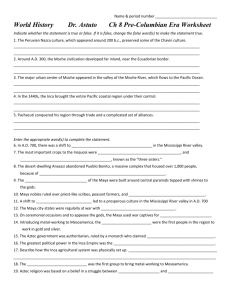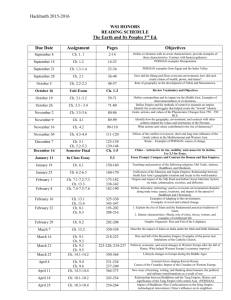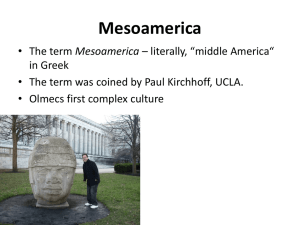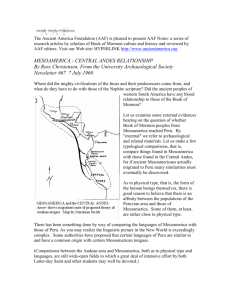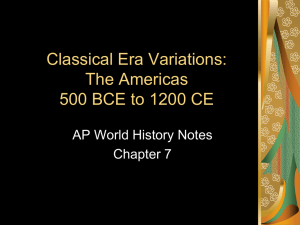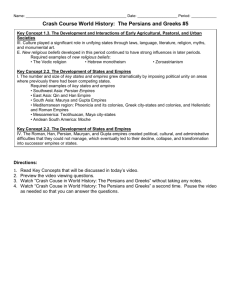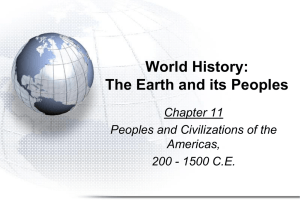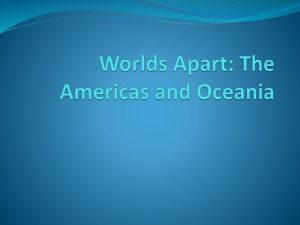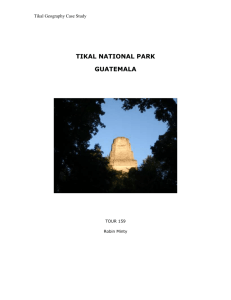ERA:
advertisement
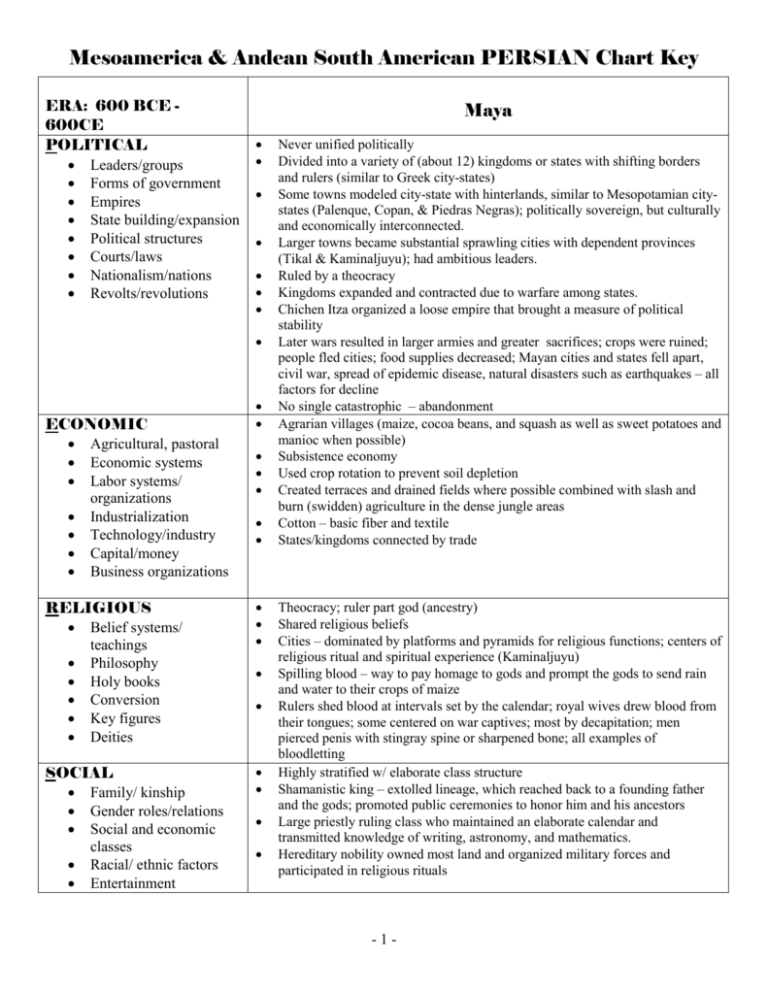
Mesoamerica & Andean South American PERSIAN Chart Key ERA: 600 BCE 600CE POLITICAL Leaders/groups Forms of government Empires State building/expansion Political structures Courts/laws Nationalism/nations Revolts/revolutions Maya ECONOMIC Agricultural, pastoral Economic systems Labor systems/ organizations Industrialization Technology/industry Capital/money Business organizations RELIGIOUS Belief systems/ teachings Philosophy Holy books Conversion Key figures Deities SOCIAL Family/ kinship Gender roles/relations Social and economic classes Racial/ ethnic factors Entertainment Never unified politically Divided into a variety of (about 12) kingdoms or states with shifting borders and rulers (similar to Greek city-states) Some towns modeled city-state with hinterlands, similar to Mesopotamian citystates (Palenque, Copan, & Piedras Negras); politically sovereign, but culturally and economically interconnected. Larger towns became substantial sprawling cities with dependent provinces (Tikal & Kaminaljuyu); had ambitious leaders. Ruled by a theocracy Kingdoms expanded and contracted due to warfare among states. Chichen Itza organized a loose empire that brought a measure of political stability Later wars resulted in larger armies and greater sacrifices; crops were ruined; people fled cities; food supplies decreased; Mayan cities and states fell apart, civil war, spread of epidemic disease, natural disasters such as earthquakes – all factors for decline No single catastrophic – abandonment Agrarian villages (maize, cocoa beans, and squash as well as sweet potatoes and manioc when possible) Subsistence economy Used crop rotation to prevent soil depletion Created terraces and drained fields where possible combined with slash and burn (swidden) agriculture in the dense jungle areas Cotton – basic fiber and textile States/kingdoms connected by trade Theocracy; ruler part god (ancestry) Shared religious beliefs Cities – dominated by platforms and pyramids for religious functions; centers of religious ritual and spiritual experience (Kaminaljuyu) Spilling blood – way to pay homage to gods and prompt the gods to send rain and water to their crops of maize Rulers shed blood at intervals set by the calendar; royal wives drew blood from their tongues; some centered on war captives; most by decapitation; men pierced penis with stingray spine or sharpened bone; all examples of bloodletting Highly stratified w/ elaborate class structure Shamanistic king – extolled lineage, which reached back to a founding father and the gods; promoted public ceremonies to honor him and his ancestors Large priestly ruling class who maintained an elaborate calendar and transmitted knowledge of writing, astronomy, and mathematics. Hereditary nobility owned most land and organized military forces and participated in religious rituals -1- Mesoamerica & Andean South American PERSIAN Chart Key Lifestyles “Haves” & “have nots” INTERACTIONS War/conflict Diplomacy/treaties Alliances Exchanges between individuals, groups, & empires/nations Trade/commerce Globalization ARTS Art Music Writing/literature Philosophy Math Science Education Architecture Technology Innovations Transportation ENVIRONMENTAL Location Physical Human/environment Migration/movement Region Demography Neighborhood Urbanization Settlement patterns Disease Cities (2 major ones) Merchants came from the ruling and noble classes, they served as traders as well as ambassadors to neighboring lands Professional architects and sculptors who oversaw construction of large monuments and public buildings Artisans specialized in the production of pottery, tools, and cotton textiles Large class of peasants and slaves Rural peasantry Developed trade networks over large distances Villages linked together though tribute payments, from lesser villages to larger, central, sacred towns Chronic warfare among high-ranked members of rival dynasties to capture victims for bloodshed Warfare consolidated control over subjects and brought tribute, sacrificial victims, and honor to military leaders. Merchants served as traders as well as ambassadors to neighboring lands Mathematical advancements – devised a calendar using precise lunar and solar cycles; concept of zero and place value (limited notational signs) Science – Study of astronomy; charted regular celestial movements with great accuracy – used in calendars Arts – pottery and carvings in stone columns and buildings Excelled at skyscrapers, especially as tombs (Tikal) Shared the same Mayan language Writing system (form of hieroglyphics) taught people they shared common histories, beliefs, and gods; also glorified the rulers and their ancestors Ball games were played to honor gods or treaties Mesoamerica (Central America) Caribbean region of the Yucatan & its interiors Present-day southern Mexico to western El Salvador Lacked large navigable rivers and irrigation systems Infertile soil May have numbered 10 million people at their peak Early form of urban sprawl; cities lacked street grids; simply added onto existing neighborhoods Tikal served as a large ceremonial center, population approaching 40,000 -2- Mesoamerica & Andean South American PERSIAN Chart Key ERA: 600 B.C.E. to 600 C.E. POLITICAL Leaders/groups Forms of government Empires State building/expansion Political structures Courts/laws Nationalism/nations Revolts/revolutions ECONOMIC Agricultural, pastoral Economic systems Labor systems/ organizations Industrialization Technology/industry Capital/money Business organizations RELIGIOUS Belief systems/ teachings Philosophy Holy books Conversion Key figures Deities SOCIAL Family/ kinship Gender roles/relations Social and economic classes Racial/ ethnic factors Entertainment Lifestyles “Haves” & “have nots” Teotihuacan Paintings and murals suggest that it was a theocracy Huge metropolis and large population indicate it had a strong source of authority. Influence extended to the Mayan city-state of Kaminaljuyu Increasing military pressure from other peoples, invaders sacked and burned the city destroying books and monuments, people left the city after about 650 CE A maize-based economy Local agrarian production covered the needs of the population Produced maize, beans, peppers, tomatoes, chilies, and cotton Extensive trade Economic influence extended to Mayan city of Kaminaljuyu Manufactured goods and trade played a large role in economy Built on cultural foundations of the Olmecs Evidence of human sacrifice, victims found with their hands and arms tied behind them Pyramid of the Sun Temple of the Feathered Serpent Gods and goddesses – feathered serpents, starfish, jaguars, flowers, and warriors Priests were crucial to the survival of the society, since they kept the calendar and ensured that planting and harvesting took place at the appropriate seasons 2/3s of the population worked the fields Artisans were famous for their obsidian tools and fine orange pottery Professional merchants -3- Mesoamerica & Andean South American PERSIAN Chart Key INTERACTIONS War/conflict Diplomacy/treaties Alliances Exchanges between individuals, groups, & empires/nations Trade/commerce Globalization ARTS Art Music Writing/literature Philosophy Math Science Education Architecture Technology Innovations Transportation ENVIRONMENTAL Location Physical Human/environment Migration/movement Region Demography Neighborhood Urbanization Settlement patterns Disease Cities (2 major ones) Extended influence in the Mayan City-States of Kaminalijuyu and Tikal Possible established trade colonies to protect their sources of obsidian throughout central Mexico Possibly militaristic, but unknown Colossal pyramids of the sun and moon; Pyramid of the sun largest structure in Mesoamerica Large number of books Paintings and murals – abstract geometric and stylized images Played ball games Orange pottery and obsidian tools Came from the arid land of northwestern Mexico Transformed their capital city into a wealthy city with avenues, spacious plazas, huge marketplaces, temples, palaces, apartment complexes, slums, waterways, reservoirs, drainage systems, and colorful murals -4- Mesoamerica & Andean South American PERSIAN Chart Key ERA: 8,000 B.C.E. – 600 C.E. POLITICAL Leaders/groups Forms of government Empires State building/expansion Political structures Courts/laws Nationalism/nations Revolts/revolutions ECONOMIC Agricultural, pastoral Economic systems Labor systems/ organizations Industrialization Technology/industry Capital/money Business organizations RELIGIOUS Family/ kinship Gender roles/relations Social and economic classes Racial/ ethnic factors Entertainment Lifestyles “Haves” & “have nots” War/conflict Diplomacy/treaties Alliances Exchanges between individuals, groups, & empires/nations Trade/commerce Globalization ARTS Economy was rooted in a complex irrigation system, requiring constant maintenance, which funneled runoff from the Andes into fields of maize, beans, and squash and acres of cotton, all fertilized by rich bird droppings Harvested anchovies (practice adopted from the Norte-Chico) Each region of the state contributed products to the larger economy of the valley: from the highlands came potatoes, llama meat and alpaca wool; the central valleys supplied maize, beans and squashes, and the coasts provided sweet potatoes, fish, and cotton. Artists left abundance evidence of a complex society with considerable specialization of labor despite no writing system. Integrated the regional economies of various Andean valleys Shaman-rulers often under the influence of hallucinogenic drugs conducted rituals, including human sacrifice from prisoners of war. Key figures & Deities INTERACTIONS Belief systems/ teachings Philosophy Holy books Conversion SOCIAL Moche or Mochica State Pan-Andes Chavin cult replaced by several regional civilizations, including the Moche by 200 B.C.E. Dominated between 100 and 800 C.E. Governed by warrior-priests Later part of the region consolidated into an Empire by the Inca Art / Music Writing/ Literature Philosophy Math / Science Education Architecture Technology/ Innovations Transportation Wealth of warrior-priest elite and the artistry of craftsmen reflected in the elaborate burials indicate immense wealth. Pottery shows life of the common people, including the blind and sick, aristocrats embarking on a hunting party, warriors leading captives bound by ropes, women working in a primitive textile factory under the careful eye of a supervisor, and beggars looking for handouts on a busy street. Rulers received messages from ambassadors from neighboring states (art). States emerged when conquers unified the individual valleys and organized them into integrated societies; coordinated the building of irrigation systems so that the lower valley could support intensive agriculture, established trade and exchange networks that tied the highlands, the central valleys, and the coastal regions together. Did not utilize a writing system to record belief systems, values, and ways of life, so we rely on interpreting their art. Scenes of ritual human sacrifice, decapitation, and body dismemberment common Elaborate burials such as the Lords of Sipan (3 men) who were buried above each other, decked out in elaborate gold masks, necklaces, and headdresses, turquoise and gold bead bracelets, cotton tunics covered with copper plates, a gold rattle showing a Moche warrior smashing a -5- Mesoamerica & Andean South American PERSIAN Chart Key ENVIRONMENTAL Location Physical Human/environment Migration/movement Region Demography Neighborhood Settlement patterns Disease Urbanization/ cities (2 major) prisoner with his was club and a copper knife. Superb skills of the craftspeople, such as metalworkers, potters, weavers, and painters Mochica state had its based in the valley of the Moche river Dominated a 250-mile stretch of Peru’s northern coast and incorporated 13 river valleys Region was subject to drought, earthquakes and occasional torrential rains associated with El Nino episodes (dramatic changes in weather patterns caused by periodic warming of Pacific Ocean currents); Moche may have feel pray to an episode such as this in the 6th cent. -6-
